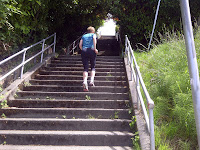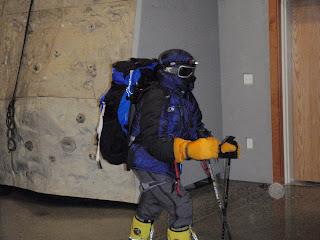Back up at 8:00 a.m. Down to the dining room for breakfast with John and Martha Carlin. Happy to see oatmeal and coffee on the buffet. I try to convince myself that I am rested when I really feel like going back to the room. There was growing concern for our team member that was getting sicker from a respiratory illness that started during the flight. This wasn't good news since respiratory illnesses can be very contagious to the rest of the team. I would try to avoid the person if possible since we were all tired and likely more susceptible to catching a virus.
We met the guides Ben and Eric at 9:30 a.m. Eric reviewed logistics and updated us on when the rest of the
team were arriving. I was fighting to stay awake as the next wave of fatigue had set in while listening to Eric. Jetlag! Several of us flew in a day early to get an extra night sleep in the hotel and some time in Arusha. I was so glad to have the extra day to rest up and relax before heading to the mountain. Eric tells us he has arranged for two trusted guides to take us around the city. Eric had just finished guiding Kilimanjaro. I thought he seemed on the thin side and very professional.
Local guides Temboche and Baraka appear in the lobby after our meeting. They speak perfect English. We are told to stay close to them to avoid being approached by over zealous street vendors. The dirt streets are filled with broken concrete and bricks. I wondered how easy going it would be after a rain. Motorcycles buzzed from all directions creating new lanes if a slower car got in the way. There seemed to be no traffic rules with some cars veering off into another lane just before impact with a head on collision. I see no accidents in either direction so there must be some harmony in the chaos. I look both ways before crossing the street, there is no pause in the traffic so we dart out behind the guides. We stroll through the city slowly taking in the atmosphere. It is very dusty, sunny and just warm enough for a light jacket.
The guides take us by Moonas Pharmacy. Always good to know where the pharmacy is located when traveling. Being unfamiliar with medication rules in Tanzania, I wasn't sure if I could purchase medications without a prescription. I would likely need to see the pharmacist to replace the sudafed that I had given to our sick teammate. We then pass by the United Nations Tribunal- NO CAMERAS! The guides give us a quick explanation about the tribunal courts and armed guards with machine guns. "Just move along and follow the rules and no trouble." We put our cameras away after passing a few smirks to each other resisting the urge to take a photo of the desolate building. While we wait at the corner to cross we see a class of schoolchildren dressed in white coming down the side walk. How adorable. Admiration fades fast after I notice a couple of the children have severe runny noses. After informing the group we should move quickly since we can't afford to be exposed to yet another virus,
we quickly cross the street and head to the market.
 Coca Cola signage is everywhere. Cameras come back out as we walk along a dirt path. We pass several local women coming and going from the market carry their goods on their head. Monique is taking photos of the old rusty coke sign when suddenly an angry woman comes running up to her yelling in Swahili. Monique is shocked and not sure what is going on. The guides explain the woman thinks her picture was taken and wants money. Monique assures the guides she was photographing the coke sign as we quickly move on.
Coca Cola signage is everywhere. Cameras come back out as we walk along a dirt path. We pass several local women coming and going from the market carry their goods on their head. Monique is taking photos of the old rusty coke sign when suddenly an angry woman comes running up to her yelling in Swahili. Monique is shocked and not sure what is going on. The guides explain the woman thinks her picture was taken and wants money. Monique assures the guides she was photographing the coke sign as we quickly move on.
We enter the market from second story stairs of an adjacent building. We can look down over the market from above. The market is amazing and must be more than an acre of open air small shops. You could feel the energy in the movement of the sellers and buyers while looking down from the top of the stairs. The market seemed to be a living thing. Lots of people selling bulk grains, vegetables, fruits, dried meats, supplies and clothing. I see a mound of dried anchovies four feet tall. People filled the streets walking on foot or riding bicycles. The larger items were carried on large wooden carts propelled by a single bicycle.

Most of the sellers are women and easy to spot wearing vivid colorful dresses and skirts. I don't see too many women wearing pants and the women that do wear pants are young. We take some photos of the market as we stroll through with amazement. The beauty of the market wasn't obvious until looking back at the photos.
Back on the streets, we pass by many buildings with iron bars and security cameras. Some street corners have armed guards with machine guns. Although this should make me feel uneasy, I felt a little safer with the Tanzanian military present to keep the peace. We were told never to go out at night. I didn't need to be told more than once to stay inside the hotel. The local people have an astonishing level of poverty. We learn later that mountain guiding pays very well for those few who are hired by the local climbing companies.
Getting hungry, we head to an Ethiopian restaurant called Spices and Herbs. I am exited to try different foods. We sat under a trellis on an outdoor patio- the perfect amount of shade. We order diet cokes and beer. I order lentils and vegetables and we all learn how to eat Tanzanian style. The flatbread- Chapati - has a distinct vinegar flavor and is used much like a utensil to manage the beans and rice. After lunch we tour more shops as we make our way back to the hotel. There are many tourist shops with African trinkets for sale. Some of the art shops grab my interest, but I am too tired to browse. After exchanging $300 for $469 shillings, we return to the hotel. Six hours of city touring was plenty for our second day in Arusha.





























